Chapter 8—
The Enigma of Rore—
Books One and Two for Five Voices
Willaert's madrigals, like his orderly place in Venice's cultural institutions, form a study in temperance and regularities. Smooth rhythmic pace, orderly projection of syntax, controlled polyphony, and subdued motivic gestures all merged in the style Willaert cultivated for the Musica nova. The consolidation of musical and personal identities with civic image that Willaert embodied as Venice's chief representative of musical decorum stemmed from mutual accommodations between composer and state. Indeed, as we saw in the Preface, the Procuratori who had hired Willaert expressly commended him as a deliberate, cautious man — a reputation admirers elaborated in his role as patriarchal head of the Venetian musical establishment.
Against the patterns of order and moderation that repeat themselves with such uniformity throughout Willaert's biographical and musical legacy, Rore cuts a decidedly more eccentric figure. This is something of a puzzle, since it was Willaert and Rore together whose madrigals of the 1540s formed the pillars of a single musico-literary project. Even a cursory comparison of the madrigals in Willaert's Musica nova with those in Rore's Primo libro a 5 of 1542 reveals correspondences between them that support this association. Both collections are based on Petrarchan sonnets set motetlike in two parts in a broad, contemplative vein. Both embed Petrarch's convoluted language in a dense mass of freely imitative polyphony, shaping it in motives that subtly change from voice to voice. And most important, both attend scrupulously to rhetorical qualities of text — sound, accent, verbal figure, and syntax.
At the same time, Rore showed remarkable independence at age twenty-six when his first book emerged seemingly out of nowhere — independence in both musical style and manner of presentation. In 1542 his works had apparently never been printed before, even in anthologies. Despite this, his Primo libro included, rather unusually, only his own works. Both that book and his Secondo libro of 1544 lacked
the dedications to patrons who typically helped support composers and underwrite their prints. Neither book contains any of the same Petrarchan lyrics found in the Musica nova, although at least some of Willaert's settings of them must have existed by those years. Moreover, the Primo libro transmits some of the most tortured lyrics in Petrarch's Canzoniere, together with several remarkably dramatic modern texts. Whatever external impulses may have urged these poetic choices on him, Rore stands apart in this respect. Not until his Terzo libro a 5 of 1548 did he print a setting of a sonnet also set by Willaert, Quando fra l'altre donne ad hora ad hora (no. 7 in the Musica nova ). Yet any deeper affinities to which such a coincidence might hint pale beside the technical and stylistic departures of the Terzo libro as a whole. With this book came radical innovations in madrigalistic conception, including the transformation of the Venetian madrigal's penchant for the monumental into the form of an immense madrigal cycle, the famed setting of Petrarch's Vergine bella.[1]
Some inkling of these innovations might be inferred from Rore's earlier books. Already in the early 1540s Rore's language was considerably more extroverted than Willaert's. The bold motivic strokes, erratic declamatory pacing, florid melismas, and disjunct melody that appear regularly in Rore's madrigals barely exist in Willaert's, and neither does the graceful cantilena to which they form a foil.[2] Furthermore, Rore accommodated an expanded range of rhythmic values by using black notation for all but two of his madrigals in the Primo libro, a notational style Willaert adopted only a few times in his career.[3] The widened expressivity allowed by black notation made for more expansive madrigals: Willaert's sonnet settings, with their steady declamation, average about 120 measures, whereas Rore's stretch to as many as 164 and routinely over 150.[4] Finally, whereas Willaert invariably broke sonnets into two parts after the octave, Rore divided a number (unconventionally)
[1] Rore's was not the first madrigal cycle to be written but the most ambitious to date. Berchem's six-part setting of Petrarch's sestina Alla dolc'ombra, ranging from three to six voices, is more typical. It appeared in Doni's Dialogo della musica in 1544.
According to Vergelli's dedication to Gottardo Occagna, Rore's Vergine cycle was known in Venice for at least some months before its publication ("già molti mesi fa"), presumably by April of that year (see Chap. 3 above, n. 32, and the purchase entry in the records of the Accademia Filarmonica di Verona cited by Giuseppe Turrini, L'Accademia Filarmonica di Verona dalla fondazione (maggio 1543) al 1600 e il suo patrimonio musicale antico, Atti e memorie della Accademia di Agricoltura, Scienze e Lettere di Verona, no. 18 (Verona, 1941), p. 22.
[2] See James Haar's observations on Rore's melodic grace and individuality and his distinctive exordia, in Essays on Italian Poetry and Music in the Renaissance, 1350-1600 (Berkeley and Los Angeles, 1986), p. 120.
For full scores of madrigals discussed in this chapter see Cipriani Rore, Opera omnia, ed. Bernhard Meier, Corpus mensurabilis musicae, no. 14, AIM, vol. 2 ([Rome], 1963).
[3] The exceptions are nos. 19 and 20. On this issue see Don Harrán, "Rore and the Madrigale Cromatico," Music Review 34 (1973): 66-81, and James Haar, "The Note Nere Madrigal," JAMS 18 (1965): 22-41. Willaert's black-note madrigals include three in the Musica nova, nos. 11, 12, and 13, and four published in anthologies (see Table 2).
[4] The longest is Il mal mi preme e non spavento un hora (164 mm.) in Book One. Close behind it are Quanto più m'avincino al giorno estremo (162 mm.), La vita fugge e non s'arresta un'hora (155 mm.), and Perseguendomi amor al luogo usato (152 mm.), all also from Book One. The sonnet settings in Book Two are somewhat shorter on average, in the range of 130 measures. (I am speaking, of course, of modern transcription, with either the breve in white notation or the semibreve in black notation equivalent to a transcribed measure.)
after the first quatrain, in line with rhetorical suggestions in their texts; for others he made no division at all.[5]
We can scarcely begin to weigh these differences without adding into the balance the mysteries of Rore's biography before he arrived at his earliest known post, in Ferrara, at latest in April or May 1546.[6] The only patrons who can be linked definitively to him in his pre-Ferrarese years in Italy are Ruberto Strozzi and Neri Capponi. As I showed in Chapter 2, Strozzi spent most of his time between about July 1538 until the late summer of 1542 in Venice. To recapitulate the most salient data on Venice's Florentine colony, the dedication to Strozzi by his viol teacher Silvestro Ganassi dal Fontego strongly suggests that musical gatherings took place at the Strozzi's Venetian house at San Canciano, probably with Ganassi participating. Capponi, who bought music from Rore as well, was evidently settled in Venice from late 1538 through at least 1544. In the early 1540s, Rore made one documented trip to Venice — and probably many more — when he visited Capponi's salon, delivered madrigals to him, and apparently made revisions (possibly with Willaert's advice).[7] From what we know, Rore probably lived mainly in Brescia, rather than Venice, before moving to Ferrara. But throughout the early 1540s his stock must have been high among cognoscenti and publishers in Venice and Ferrara (where Strozzi would surely have championed him with the duke): all the evidence suggests Rore stood at the center of those guarded Florentine exchanges that saw the new Italo-Netherlandish idiom as a prized commodity.
These circumstances form the backdrop to Rore's first two books. In a different way each book raises questions about Rore's relationship to Venice: Book One to the genesis of Venetian style, to newer Venetian developments like modal ordering and black notation that appeared in the most modish prints, and to Willaert; Book Two to the eclecticism and occasional side of Venetian print culture, to the genre of anthologistic prints it produced, and to the directions taken up by less celebrated contemporaries. The remarkable changes appearing in Rore's Third Book lead ultimately out of the muted rhetoric practiced by Venetian madrigalists and into the more demonstrative style of Rore's late madrigals and madrigals by his students Giaches de Wert and Luzzasco Luzzaschi working in northern Italian courts. I will return to these directions in Chapter 10, after assessing the response Willaert's immediate students at San Marco made to the stylistic equipoise — this narrow play of alternatives — that was formed between Willaert's Musica nova and Rore's first two books.
[5] Sonnets that divide after the quatrain include nos. 9, 15, and 16 in Book One and nos. 16, 20, and 24 in Book Three. Sonnets set with no division include no. 6 in Book One and no. 21 in Book Three. Willaert sometimes did the same, as in Qual anima ignorante, published in Rore's Book Two, but never in setting Petrarch's sonnets.
[6] See Jessie Ann Owens, "The Milan Partbooks: Evidence of Cipriano de Rore's Compositional Process," JAMS 37 (1984): 270-98. Further citations for what follows can be found in Chap. 2 above, nn. 3 and 35.
[7] This was shortly after Strozzi left Venice. See Richard J. Agee, "Ruberto Strozzi and the Early Madrigal," JAMS 36 (1983): 12-13, and Chap. 2 above, n. 35 and Table 1.
Madrigali a Cinque Voci (1542): Petrarchan Woods in the Shadow of Dante
The twenty poems of Rore's First Book form a corpus of intriguing thematic tendencies. Several overlapping textual motifs recur often enough to raise the possibility that a loosely related thematics influenced the way the book was shaped, even if it carried no overarching lyric program. Central to these thematics is what I have elsewhere described as a dissident strain of Danteism manifest in extremes of materia and forma — harsh subjects delivered in rough-hewn language — that most contemporary critics must have sensed as dangerously uncontained.[8] To be sure, the book's outward alliance with the puristic variety of Petrarchism found in Venice, which was just then being adapted to musical repertory, belies this "Dantean" strain: twelve of the book's twenty settings are of Petrarch. Nonetheless, the combination of dramatic Petrarchan sonnets and starkly graphic modern ones betrays leanings quite alien to the orthodox Petrarchism of Bembo and his adherents.
To its audience in 1542 what must have seemed most remarkable about the collection were the sixteen sonnets, grouped contiguously as nos. 2-17, that make up the main body of the print, as shown in Table 6.[9] No previous book of music had collected so many sonnet settings in one place or rendered them with such intensity. Situated at the peripheries of the print are four lighter poems in less weighty forms — one at the start and three at the end. An informed observer might have noticed symmetries in the placement of these outer numbers too. At the book's extreme ends are its only two ballate, both by the Venetian poet Giovanni Brevio, whose reputation in the city included his minor role in Bernardino Daniello's La poetica published six years earlier.[10] Just inside them sit, toward the front, Petrarch's sonnet Hor che 'l ciel e la terra e 'l vento tace (no. 2) and, at the back, an anonymous cinquecento madrigal Hor che l'aria e la terra (no. 19) that glosses some of the former's famous themes and lexicon. Rore's Hor che l'aria reinforces the parallel by dividing the madrigal's eleven lines (quite unusually) into two halves along the lines of his sonnet setting.
These structural features of the book's layout are compatible with its systematic (and more widely recognized) organization by mode.[11] The Primo libro is the first book known to have been successively ordered by mode according to the traditional numbering 1 to 8 (see Table 6). The plan extends only through no. 17,
[8] See my "Rore's 'selva selvaggia': The Primo libro of 1542," JAMS 42 (1989): 547-603.
[9] The many later editions of the book altered this arrangement substantially through additions, deletions, and reorderings. For listings of these see Il nuovo Vogel 2:1479-85 (nos. 2389-2400) and for Gardane's edition of 1544, Mary S. Lewis, Antonio Gardane, Venetian Music Printer, 1538-1569: A Descriptive Bibliography and Historical Study, vol. 1, 1538-49 (New York, 1988), pp. 429-35 (no. 57).
[10] See Chap. 5 above, n. 10. The poems appear in Giovanni Brevio, Rime e prose volgari di M. Giovanni Brevio (Venice, 1545), fols. B V and C III'.
[11] On modal organization in Rore's madrigals see Bernhard Meier, The Modes of Classical Vocal Polyphony Described according to the Sources, trans. Ellen S. Beebe, rev. ed. (New York, 1988), and Jessie Ann Owens, "Mode in the Madrigals of Cipriano de Rore," in Essays in Italian Music in the Cinquecento, Altro Polo, ed. Richard Charteris (Sydney, 1990), pp. 1-15.
| ||||||||||||||||||||||||||||||||||||||||||||||||||||||||||||||||||||||||||||||||||||||||||||||||||||||||||||||||||||||||
(Table continued on next page)
(Table continued from previous page)
| ||||||||||||||||||||||||||||||||||||||||||||||||||||||||||||||||||||||||||||||||||||||||||||||||||||||||||||||||||||||||||||||
however, the same place that marks the end of the bank of sonnets.[12] What was given modal order, in other words, was essentially the sonnet.[13] And what was new about the print was therefore not just modal ordering, but the nexus of modes and sonnets.[14]
All in all, then, Rore's book was a novel essay in sonnet setting. Despite the many occasional sonnets written in the mid-sixteenth century, sonnets remained a primary vehicle for remote, archetypal forms of expression (as we saw in Chap. 7). Accordingly, the book avoids occasional verse almost completely,[15] emphasizing instead two interrelated themes: death — both feared and augured — and the untamed wilderness. The recurrence of these themes casts a veil of despair over the whole book, a feeling epitomized by the burst of vengeance that opens Petrarch's Far potess'io vendetta di colei (Canzoniere, no. 256).
Far potess'io vendetta di colei Could I but take vengeance on her
Che guardando et parlando mi distrugge Who gazing and speaking destroys me
E, per più doglia, poi s'ascond'e fugge, And then, to increase my pain, hides herself and flees,
Celando gli occhi a me sì dolce e rei! Taking from me her eyes so sweet and cruel!
Far potess'io vendetta explores a soundscape that challenges the limits of what Bembo later described as "materia grande" and the vocabulary he called "gravi, alte, e sonanti."[16] Consonantal clusters and abundant a 's and o 's slow the poem's rhythmic pace, especially in v. 2 ("Che guardando e parlando mi distrugge"), and fill its
[12] Does this mean that nos. 18-20 must have been a "foreign body incorporated only after the original had been submitted for printing," as Bernhard Meier assumed (Rore, Opera omnia 2:iii)? Apropos, we might consider that had the two madrigal texts (nos. 18 and 19) been interpolated among settings in modes 1 and 2 and Brevio's second ballata (no. 20) among settings in mode 3, the book's solid bank of sonnets would have been interrupted. Why the first Brevio ballata (no. 1) should not have been relegated to the back of the book as well apparently had to do with the bookmakers' notion that madrigal prints should not open with a sonnet but with something lighter. To judge from the makeup of subsequent collections published by Willaert's students, the Primo libro set a precedent for avoiding weighty sonnets at the starts of books in which they otherwise dominated. All of the following sonnet-filled prints open with cinquecento madrigals: Perissone Cambio, Madrigali a cinque voci (1545), with twelve sonnets out of sixteen settings; idem, Il segondo libro de madregali a cinque voci (1550), with fifteen sonnets out of twenty-three; Girolamo Parabosco, Madrigali a cinque voci (1546), with eight out of twenty; and Baldassare Donato, Il primo libro d'i madregali a cinque & a sei voci (1553), with thirteen out of twenty-six.
[13] It may be relevant here that the one ballata that departs from the pattern, no. 1, consists of fourteen lines of endecasillabi.
[14] This is not at all the same as saying that the meanings of the individual sonnets were keyed to modal affect, a different matter that I will take up briefly below. It does seem likely, however, that there is a connection between modal ordering and a highly literary vernacular. For a suggestion that composers sought "pathic and ethic effects" of modes particularly in secular (hence almost always vernacular) music, see Chap. 6 above, n. 26.
[15] Even Altiero sasso (no. 6), described by Einstein as a "threnody on the death of a Roman" (The Italian Madrigal 1:393), is couched in a generalized poetics, with no direct hint of its subject's identity. The only other quasi-occasional text in the book is no. 18, a chivalric madrigal for an anonymous "Rosa": "Ben si conviene a voi / Così bel nome, alma mia rosa poi / Che con quella beltà che 'l monda honora, / Vincete i più bei fiori / E i più soavi odori" (Well does such a lovely name suit you, my life-giving Rosa, since with that beauty that the world honors, you surpass the loveliest flowers and the sweetest aromas).
[16] Prose della volgar lingua, ed. Mario Marti (Padua, 1967), p. 55.
rhymes with what Bembo had called a "meravigliosa gravità.[17] This "grave" diction culminates in the clamorous rhymes of the sestet ("caccia" / "sciolta" / "minaccia", "volta" / "abbraccia" / "s'ascolta") and the bitter rebuke of its final point, where Petrarch embeds the o 's in a slew of hissing s 's: "Non rompe il sonno suo s'ella l'ascolta" ([My lamenting soul] does not break her sleep, if she is [even] listening).
Even though Far potess'io vendetta does not explicitly portend loss, it comes from a sonnet cluster that brings the entire Canzoniere to a nadir of despair with Laura's death in no. 264, and the beginning of the sonnets "in morte." This sonnet cluster, beginning with no. 250, positions the poet's fantasy on the edge of reality by slipping repeatedly into scenes of tormented sleep. Rore also set the very first of the group, Solea lontana in sonno consolarme (Accustomed from afar to console me in sleep), in which Laura announces in a nocturnal vision her imminent death ("Non sperar di vedermi in terra mai" [Do not hope to see me on earth ever again]). Several other poems in Rore's book deal centrally with death — Poggiand'al ciel coll'ali del desio (no. 3), an anonymous gloss on the motif of Icarus who flies so high from love that his wings are melted by the sun, Altiero sasso lo cui gioco spira by Francesco Maria Molza (no. 6), a eulogy on a Roman (see n. 15 above), and Petrarch's La vita fugge e non s'arresta un'hora (no. 8) and Chi vol veder quantunque po natura (no. 14) — and most of the other poems in the book touch on death at least tangentially.
The related topos of the savage wilderness staged at the center of Rore's book had its most gripping prototype in Dante's Divina commedia, particularly (as I have argued elsewhere) as the "selva oscura" with which Dante begins his prologue scene.[18] In the Commedia, of course, the dark woods represents a space of primitivity and spiritual blindness. Its power to terrorize the soul motivates the beginning of a conversion that will take the poet on a harrowing odyssey through Hell and into those linguistic regions that were forbidden by the codifiers of Tuscan who later prevailed in Venice.
The three sonnets that pursue the topos in Rore's Primo libro (nos. 6, 7, and 11) aspire to varying degrees of Dantean intensity. The most moderate, Petrarch's Per mezz'i boschi inhospiti e selvaggi (no. 11), mediates between Dantean and Petrarchan extremes. Its evocative nature scene is painted as a familiar symbol of spiritual loss, but also of comfort — a symbol caught, in typically Petrarchan fashion, in a web of uncertainties.
Per mezz'i bosch'inhospiti e selvaggi Through the midst of the inhospitable savage woods,
Onde vanno a gran rischi'homini et arme, Where even armed men go at great risk,
Vo secur'io, che non po spaventarme I go without fear, nor can anything terrify me
Altri che 'l sol, c'ha d'Amor vivo i raggi; Except the sun that has rays from living Love. 4
[17] Ibid., p. 81.
[18] Feldman, "Rore's 'selva selvaggia,'" from which some of what follows is drawn. For antecedents to Dante's exploration, particularly those of Virgil, see The Divine Comedy, ed. and trans. Charles S. Singleton, 3 vols. (Princeton, 1970), vol. 1, pt. 2, pp. 4-5; and John Freccero, "The Prologue Scene," Chap. 1 in Dante: The Poetics of Conversion, ed. Rachel Jacoff (Cambridge, Mass., 1986).
E vo cantando (o pensier miei non saggi!) And I go singing (oh my unwise thoughts!)
Lei che 'l ciel non poria lontana farme, About her whom the heavens could not put far from me,
Ch'i' l'ho ne gli occhi, e veder seco parme For she is before my eyes and with her I seem to see
Donn'e donzelle, e sono abeti e faggi. Ladies and damsels, and they are but firs and beeches. 8
Parmi d'udirla, udendo i rami e l'ore I seem to hear her when I hear the branches and breeze
E le frondi, e gli augei lagnarsi, e l'acque And the leaves, and birds lamenting, and the waters
Mormorando fuggir per l'herba verde. Murmuring, fleeing across the green grass. 11
Raro un silentio, un solitario horrore Rarely has the silence, the solitary horror
D'ombrosa selva mai tanto mi piacque, Of a shady wood pleased me so much;
Se non che dal mio Sol troppo si perde. Except that I lose too much of my Sun. 14
Unlike the dread that shadows Dante's journey, here the lover willingly seeks uninhabited places since nothing can harm him but the sun — metaphor, that is, for Laura and for the enlightened, hence civilized, life. In this pagan forest love is ubiquitous and comforting, yet also ambiguously elusive, as we learn in v. 4 and again in the last tercet. There the shaded woods of Dante's Commedia reappear, but since they offer solace (protection from the sun) their meanings are enervated by Petrarchan ambivalence. They point at once to the presence and absence of the beloved. By contrast with the sonnets of Rore's southern contemporaries that I will take up shortly — sonnets that delve deeply into the penumbral wilderness Dante had explored — Petrarch's sonnet leans at once in and out, tempering and softening its linguistic signs in a way that appealed to Venetian literati.[19]
As a text that reconciles these verbal-thematic extremes, Per mezz'i boschi offers a valuable way to consider the range of discursive possibilities that Rore's readings made use of. His setting is far more animated than those of Willaert, defined by clear contrasts and lively gestures (see the complete setting in Ex. 18). This squares well with the Rore of the late fifties whom Claudio Monteverdi later called the father of the seconda prattica — those experiments in extravagant harmonic and voice-leading effects in the service of text expression that he compared with the more constrained prima prattica employed by composers from Josquin to Willaert. Yet in the early forties Rore's language evinced virtually none of the harmonic experiments or overt text painting that were to invite that label. How his earliest settings managed to construe text so vividly is a question that must be searched out in other domains — in the way his rhetoric simultaneously shapes verbal syntax and meaning.
[19] Meier misrepresents the sonnet by reducing it to an expression of Petrarch's fearlessness in imagining Laura — this by way of explaining Rore's use here of fifth mode, traditionally conceived as cheerful (The Modes, p. 394). Petrarch's contradictory relationship to sun and light, and thus to Laura, is a theme that runs throughout the Canzoniere (e.g., nos. 18 and 22). Indeed the originary fiction of the Canzoniere describes the day he first sighted Laura as "il giorno ch'al sol si scolararo / per la pietà del suo fattore i rai" — that is, the anniversary of Christ's Crucifixion (no. 3, vv. 1-2). Far from being avoided by madrigalists, such contradictions were sought out.
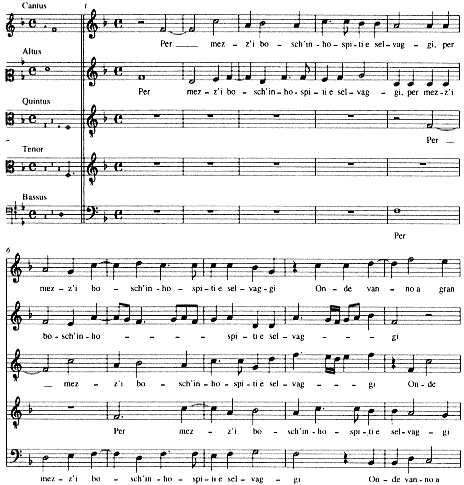
Ex. 18.
Rore, Per mezz'i bosch'inhospiti e selvaggi (Petrarch, no. 176), incl.; Madrigali
a 5 (Venice, 1542), no. 11.
(continued on next page)

Ex. 18
(continued)
(continued on next page)
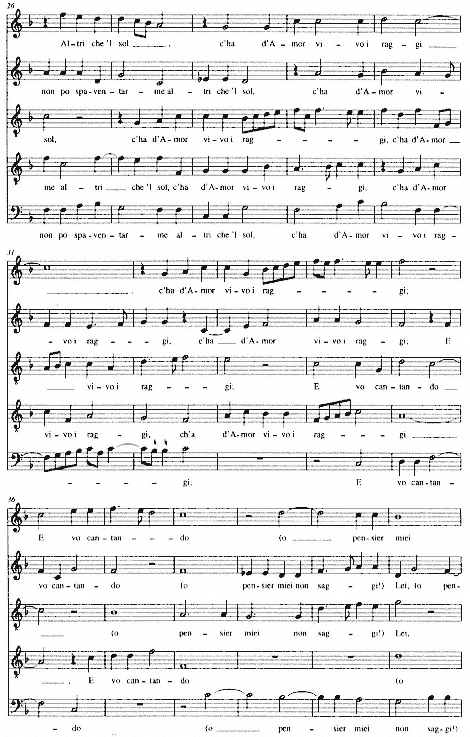
Ex. 18
(continued)
(continued on next page)
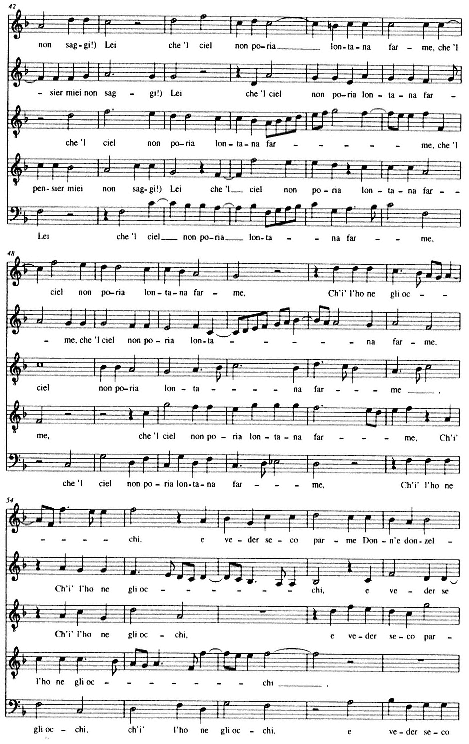
Ex. 18
(continued)
(continued on next page)
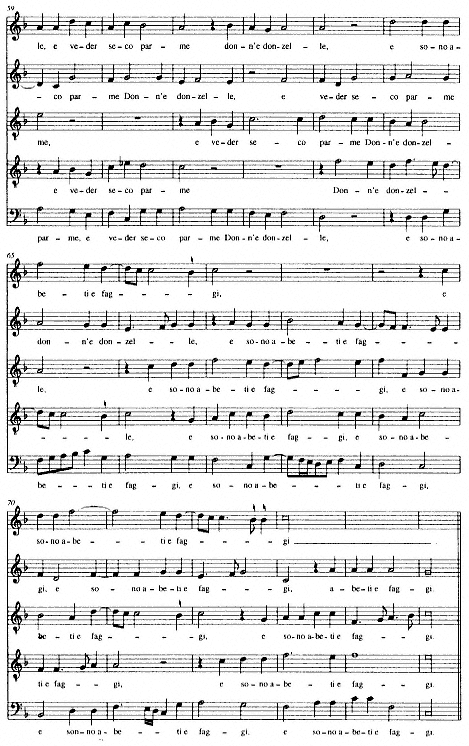
Ex. 18
(continued)
(continued on next page)
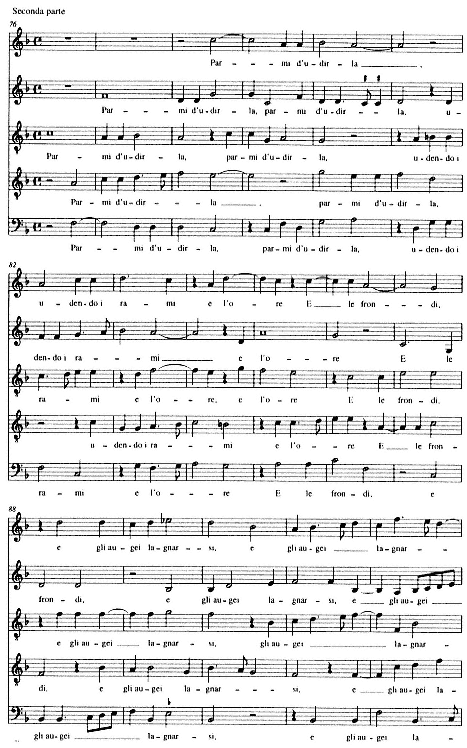
Ex. 18
(continued)
(continued on next page)
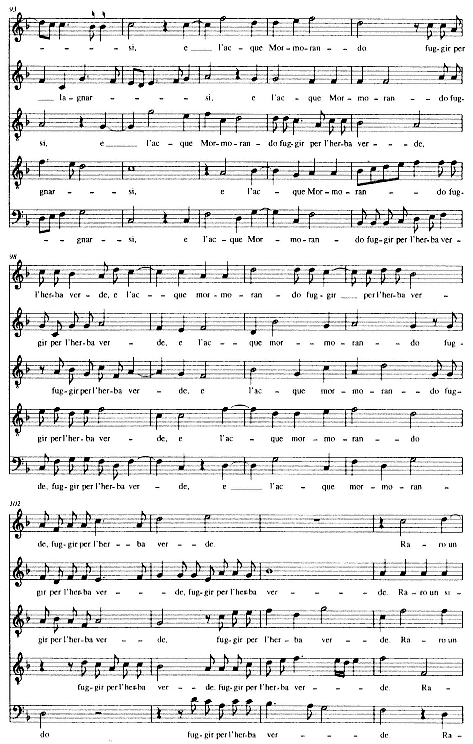
Ex. 18
(continued)
(continued on next page)
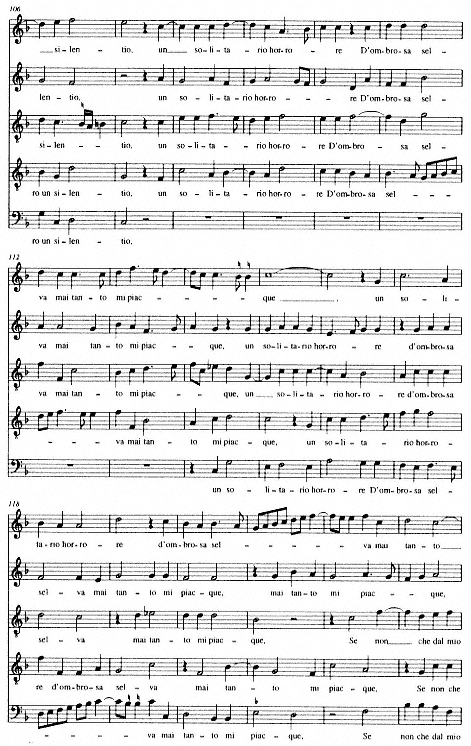
Ex. 18
(continued)
(continued on next page)
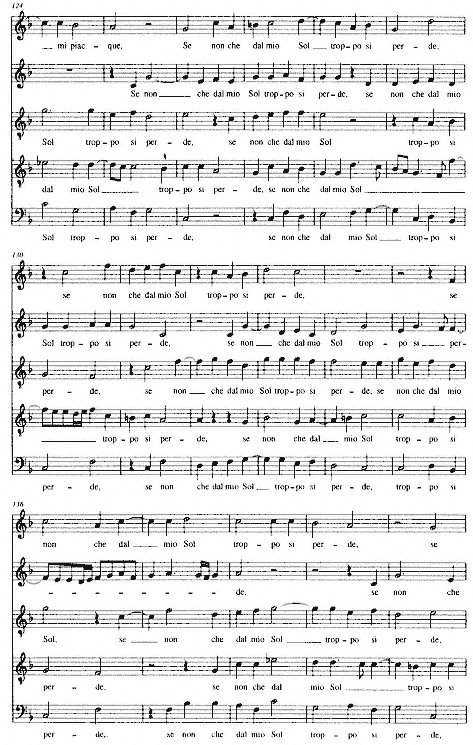
Ex. 18
(continued)
(continued on next page)
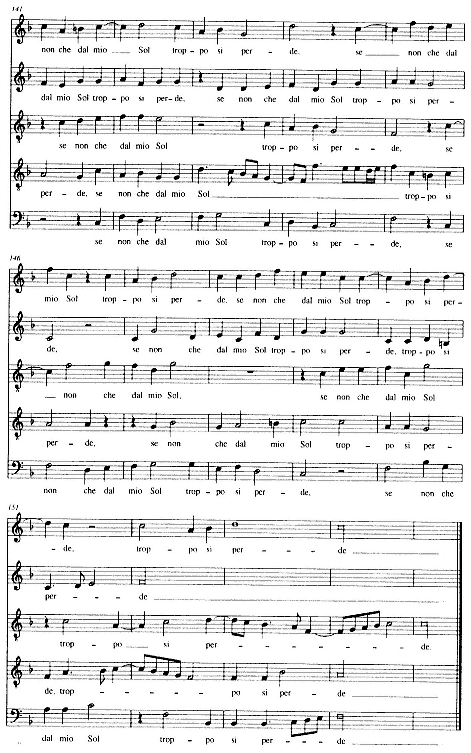
Ex. 18
(continued)
(continued on next page)
We can begin to uncover this rhetoric by looking at Rore's treatment of the sonnet's formal articulations, as provisionally described in Table 7. Although the ambiguities of Rore's counterpoint render such descriptions problematic,[20] Table 7 nonetheless shows that his setting foregrounds the sonnet's verse structure by using suspension cadences repeatedly at the ends of all but one of the sonnet's main sections (cf. vv. 4, 8, and 14). The only section that lacks such a cadence is the first tercet, with a single cadence to end v. II at m. 105, but here Rore reinforces the articulation through other means (as I discuss below). Furthermore, suspension cadences sound at the ends of virtually every clause (the only exceptions are the very last cadences that close each of the two parts).
This structural overview allows us to see profound differences between Rore and Willaert. Rather than trading in suspension cadences and sharp motivic differentiations, Willaert tended to work with speechlike recitation, often marking textual cadences through the simple use of rests.[21] Willaert's madrigals must have offered trenchant models for how to define formal details of text with subtle rhythmic and harmonic nuances and delicate textural shifts; but Rore sought out more explicit rhetorical definition.[22] While Willaert's madrigals usually deploy few contrapuntally conceived cadences, Per mezz'i boschi typifies Rore's tendency toward a highly articulated reading.
This profusion of contrapuntal cadences was just one way Rore's articulation differed from Willaert's, however, and perhaps not even the most obvious one. For Rore, semantic content held equal sway with linguistic form. More than Willaert's, his music indulged in vivid text painting and sharp verbal contrasts, bold motivic shapes and striking expositions. One result of these tendencies was a less regular rhythmic surface. Thus, where Willaert's declamation distributes durations fairly evenly over words in the course of a sonnet, Rore's moves between this Willaertian "speech time" and what we might usefully distinguish as "expressive time," time played out in alternately lingering or quickening affective gestures and pictorial effects. In short, Rore forewent some of Willaert's rigorous adherence to the
[20] As with Willaert's Pien d'un vago pensier (see Table 5), Rore's setting is not wholly congenial to this kind of simplified description. Both the contrapuntal ambiguities and the subtle and diverse means by which articulations are made defy efforts to summarize the forms of many cadences or even to identify all their locations. Rore parses the text not just through contrapuntal devices but through textural shifts, changes in declamatory speed, text repetition, and a host of other means. Table 7 lists all of the cadences involving suspended dissonances, as well as others that I deem especially significant, but for the reasons given above I do not aspire to a universal or wholly systematic approach in tabulating cadences.
[21] The total lack of suspension cadences in the prima parte and inclusion of only two in the seconda parte of Willaert's Mentre che 'l cor find no equivalent in Rore's books. Meier's tabulations of cadences for several madrigals from the Musica nova might seem to suggest otherwise, but his examples happen to be drawn from the most cadence-laden works in the book. See the sections on Giunto m'ha Amor and Quando fra l'altre donne in The Modes, pp. 144-45 and 159 (I do not count the seven-voice dialogues that Meier discusses on pp. 126-27 and 145 because they operate according to different principles of articulation).
[22] For a study aimed at demonstrating Rore's mastery in reflecting textual structure through bass patterns, tonal structure, and cadential repetitions see Jessie Ann Owens, "Music and Meaning in Cipriano de Rore's Setting of Donec gratus eram tibi," in Music and Language, Studies in the History of Music, vol. 1 (New York, 1983), pp. 95-117, on his setting of an ode by Horace.
| ||||||||||||||||||||||||||||||||||||||||||||||||||||||||||||||||||||||||||||||||||||||||||||||||||||||||||||||||||||||||||||||||||||||||||||||||||||||
tempos, accents, and cadences of a spoken reading in favor of a more semantic interpretation.
Per mezz'i boschi carefully balances such formal and expressive considerations in the transitions between major structural divisions. When the first quatrain draws to a close, for example, a series of brilliant melismas gestures the word "raggi" repeatedly toward cadence (quintus, mm. 28-30; bassus, mm. 30-32; cantus, mm. 33-35). Crowning the quatrain with their whimsical swirling motions launched across
sevenths and propelled in thirds and fourths, these melismas bring about the quatrain's tonal-grammatical resolution to the final, F. At the same time, by calling attention with their sudden absence to the poet's singing in v. 5 ("E vo cantando") and the beginning of the new poetic thought, they also exaggerate retrospectively the loss of motion in m. 35. To employ stasis for the sake of contrast at such a moment is a touch ironic, of course, since Rore can exploit it only by slighting the prevailing convention that prescribed florid melody for allusions to singing. But in pitting such a spare passage against the previous spate of melismas — condemning the poet's reckless song to a spell of semantic impoverishment — Rore found an efficacious formal-cum-expressive solution to the structural transition.
"E vo cantando" forms only the first part of a clause whose direct object "Lei" is displaced in enjambment to line 6 through an extraordinary interruption. It is worth pursuing these verses a little further to notice the ingenious syntactic solution given to Petrarch's exclamatory "(o pensier miei non saggi!)"; for Rore offset it with rests, as if to mark it as a parenthetical mental flash, and also reintroduced a declamatory rhythm at the semibreve (mm. 37-38) not heard since the opening. The new pacing marks the poet's "unwise thoughts" as intrusive and other, an effect heightened by the flat-footed binary figures that declaim "E vo cantando." Only when the phrase elides into v. 6 to complete the interruption — — "E vo cantando . . . Lei" — is the stasis of v. 5 lifted; trace the quintus from m. 37 to 41, for instance, and note the continuous and rising phrase that accompanies "saggi!) Lei" at each appearance.[23] The quintus, leading off as surrogate bass, immediately introduces a proliferation of voice crossings with the tenor that obscure and destabilize the sense of a bass line (mm. 37-39 and 44-45). Shortly afterward, the altus's flatted inflections herald a raft of minor triads, which otherwise scarcely appear in the madrigal (note the c, g, and a of mm. 39-41). None of the polyphony to this point has been tied off with a cadence. Indeed, for the first time in the madrigal, two whole verses go by before a suspended cadence sounds at the end of v. 6 (m. 53) — both the first Phrygian cadence and the first on the medial degree aa/a (altus and quintus), albeit immediately extended.
To summarize, vv. 4-6 gloss Petrarch's text in a way that moves between two different rhetorical goals: syntactic clarification and semantic expression. Whereas Willaert made interpretation of localized grammar an overriding concern — indeed often the sole means of enhancing the sense of the words — Rore's music wrested meaning directly from text. So doing, it balanced the competing demands of linguistic form and meaning.
[23] As Willaert did with the interruption in v. 8 of Pien d'un vago pensier (see Chap. 7 above, nn. 56-58), Rore clarified the words' syntactic autonomy by setting them off musically from the first part of the clause they interrupt, "E vo cantando." He also, like Willaert, linked the delayed completion of the main clause, "Lei," to the disruptive interjection: hence "(o pensier miei non saggi!) Lei" became a single syntactic unit.
Such balance proves expressively vital for the wonderfully pictorial first tercet, a catalogue of natural phenomena that Rore depicted in vivid musical images. Each item — branches, breeze, leaves, and birds — forms collectively part of a sonorous contrapuntal thicket used to animate Petrarch's scenery. To mimic the sound of the breeze whipping light rain over a field, for instance ("e l'acque / Mormorando fuggir per l'herba verde"), Rore set voices fluttering from part to part (mm. 93-105) and underpinned the effect with a rocking bassus at mm. 94-97 and 99-102. Such rich iconic tapestries were unusual at the time, even in Rore's own madrigals. In the future, rapid declamation combined with repeating note pairs such as Rore applied to "fuggir per l'herba verde" were to become a prominent musical topos for depictions of pastoral landscapes. They surface in black-note madrigals of the 1540s, of which those in Rore's Primo libro are early, if atypical, examples, and they continue to appear in madrigals of the seconda prattica. Rore's Terzo libro of 1548 is the first to make extensive use of such pictorial passages, which finally became part of an established tradition in the pastoral settings of Andrea Gabrieli, Wert, Marenzio, and Monteverdi.[24]
Even the bravura multiple counterpoint Wert fashioned for Vezzosi augelli, a stanza from Tasso's Gerusalemme liberata published in his Ottavo libro a 5 of 1586 (Ex. 19), finds its prototype in Per mezz'i boschi. Wert's madrigal pits a melodious trio of "singing birds" for Tasso's first two verses against monotonal chanting for the murmuring breeze of v. 3. Not dissimilarly, Rore assigned separate motives to "l'acque / Mormorando" and "Fuggir perl'herba verde." To do so he had forcibly to disengage the verbal parts, for their syntax alone does not call for them to be parsed as such. The separations he artificially forced on them provide the basis for what we might call prospectively a Wertian counterpoint, which takes shape in the overlappings of mm. 95-97 and 100-102. They form a striking precedent for the sort of simultaneous counterpoint Monteverdi was to cultivate so extensively beginning in his Secondo libro a 5 of 1590.[25]
Rore projected another efficacious rhetorical-grammatical shift by articulating the division of the tercets with the perfect cadence on f/F in m. 105. The reasons for this are evident, as Rore starts the brief "Raro un silentio" in near homorhythm and quickly ends with yet another perfect cadence in m. 107 (these being the only two to bring as many as four voices to a simultaneous close). The textural tranquillity thus achieved and enhanced by an all-vocal rest in turn sets up the poem's key phrase, "un solitario horrore / D'ombrosa selva mai tanto mi piacque." At this point the texture unravels just slightly until, reaching their second statement, the voices begin to hurtle toward an enormous coda.
Rore placed unprecedented weight on the last verse. Melismas now proliferate as each voice echoes the final verse six, seven, or more times, working out at last the
[24] See Gary Tomlinson, Monteverdi and the End of the Renaissance (Berkeley and Los Angeles, 1987), pp. 49-50, and Chap. 7 above, n. 53.
[25] Tomlinson, ibid., relates Wert's Vezzosi augelli to Monteverdi's setting of Tasso's lyric poem Ecco mormorar l'onde, another paratactic nature scene, which was published in Monteverdi's Secondo libro.
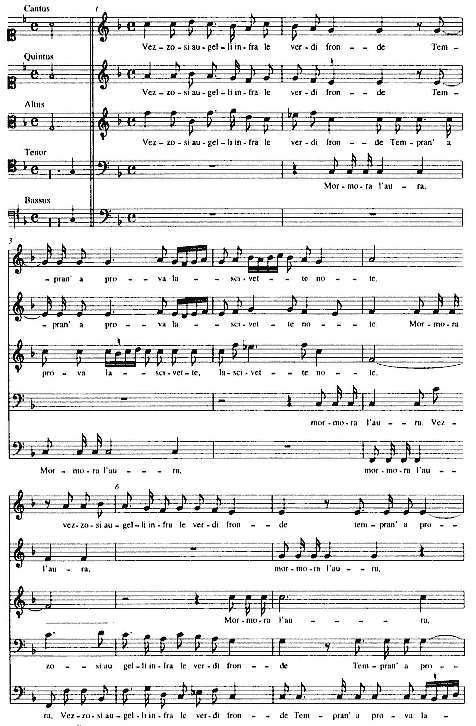
Ex. 19.
Giaches de Wert, Vezzosi augelli infra le verdi fronde (Torquato Tasso), mm.
1-9; in Ottavo libro a 5 (Venice, 1586), p. II.
(continued on next page)
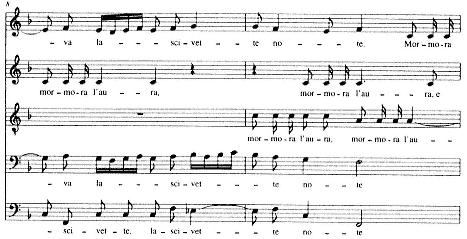
Ex. 19
(continued)
abundant polyphonic energy collected in the previous hundred-plus measures. Through all this the bass leaps back and forth between the two tonal axes, F and C, as if purging the tonal terrain of all the alien inflections that had invaded earlier. This is a fitting climax to a work that set new standards of vigor for polyphonic madrigals.
Both of the other sonnets that explore the topos of the woods were the work of poets contemporary with Rore, and both are darker than Petrarch's Per mezz'i boschi. The first (no. 6) is Molza's Altiero sasso.
Altiero sasso lo cui gioco spira Proud stone whose ridge breathes
Gli antichi honor del gran popul di Marte, The ancient honor of the great populace of Mars;
Fiume che fendi questa e quella parte, River that breaks this way and that,
Hor quieto e piano, hor pien di sdegno et ira, Now quiet and still, now full of rage and fury; 4
Piaggie che 'lmondo ancor ama e sospira, Slopes that all the world still loves and desires,
Consecrate da tante e da tai carte, Consecrated by so many and such writings;
Memorie eterne e voi reliquie sparte Eternal memories and you, Spartan relics,
Ch'ogni bon'alma con pietà rimira: On which every good soul gazes with devotion: 8
Parmi d'udir fuggendo a voi d'intorno I seem to hear flying all about you,
Sospirar l'onde e i rami e i fiori Sighing, the waves, and branches, and flowers,
e l'ora and the breeze
Lagnarsi, e per dolor romper i sassi; Lament, and the stones break from grief, 11
Che già del pianto s'avicina el giorno Since already the day of tears draws near
Che 'l bel viso ch'Italia tutta honora, When the beautiful face that all of Italy honors,
Cinti d'horror al suo partir vi lassi. Wrapped in horror at his departure, will leave you. 14
Altiero sasso apostrophizes deserted formations in the Roman out-of-doors — a stony mountain face, raging river, slopes, and Spartan relics. The poem sustains a level of Dantean gloom throughout the octave, then shifts to a lighter Petrarchan vein, conjuring up in waves, branches, flowers, and breeze the memory of the beloved. This first tercet is, of course, a gloss on the analogous one in Per mezz'i boschi. But here day breaks to provide a mere foil for the final tercet. The sonnet resumes its lamenting tone at v. 12, now draping the octave's rocky landscape in a Dantean "horror" to convey the air of deathly departure at the sonnet's end.
Rore set Altiero sasso in

Strane ruppi, aspri monti, alte tremanti Strange cliffs, harsh mountains, high quivering
Ruine, e sassi al ciel nudi e scoperti, Ruins, and stones naked and exposed to Heaven,
Ove a gran pena pon salir tant'erti Where with great effort such steep clouds
Nuvoli, in questo fosco aer fumanti, Of smoke rise in this gloomy, fuming air, 4
Superb'horror, tacite selve, e tanti Proud horror, silent woods, and so many
Negr'antr'herbosi, in rotte pietre aperti, Black grass-grown caves in broken-open stones,
Abbandonati, sterili deserti, Abandoned, barren deserts
Ov'han paur'andar le belve erranti: Where even wandering wild beasts go in fear: 8
A guisa d'hom che da soverchia pena As a man who, with a sad heart, torn with
Il cor trist'ange, fuor di senn'uscito, Excessive pain, out of his mind,
Se 'n va piangendo, ove la furia il mena, Goes crying wherever his madness leads him, 11
Vo piangend'io tra voi, e se partito I go weeping among you: and if Heaven does not
Non cangia il ciel, con voce assai più piena take my side, with a much fuller voice
Sarò di là tra le mest'ombre udito. Will I be heard from there among the sad shades. 14
Though attributions of its authorship are mixed, Strane ruppi appears to be the work of the Neapolitan Luigi Tansillo, who was noted for his extraordinarily raw diction.[26] Its trembling rocks, clouds of smoke, and lifeless woodland depict the spoils of a volcanic eruption. In evoking them with such graphic language, Tansillo departs radically from the Petrarchan mainstream, as well as from the idyllic Arcadian world of his Neapolitan predecessor Sannazaro.[27] Here the poetic persona is set in a stark and terrifying place that transforms the usual pastoral scenes of Petrarchan verse: unlike their docile woods and groves, these spaces are rugged and
[26] I expand on questions of authorship in "Rore's 'selva selvaggia,'" pp. 565-66. On Neapolitan Petrarchism see Aldo Vallone, "Di alcuni aspetti del petrarchismo napoletano (con inediti di Scipione Ammirato)," Studi petrarcheschi 7 (1961):355-75, and Giulio Ferroni and Amedeo Quondam, La locuzione artificiosa: teoria ed esperienza della lirica a Napoli nell'età del manierismo (Rome, 1973).
[27] On settings of Tansillo in the sixteenth century see my "Rore's 'selva selvaggia,'" p. 566 n. 30.
uninhabitable. All the poet's emotions are projected through this violent landscape, whose images express a total loss of civilization and, by extension, the loss of reason that defines a cultivated being. At the verbal level madness is dramatized most acutely in the octave, with its fragmentary vocatives distancing it from the equivocal syntactic convolutions of Petrarch's verse.
Elsewhere I have proposed that Tansillo drew from Dante's Commedia for specific words and meanings and more generally from the cacophonous sounds of the Inferno.[28] The "tremanti ruine" of Strane ruppi recall the rumblings of Purgatory Dante feels in Hell, to which he is doomed but for the grace of Heaven.[29] In the Inferno he learns through a series of cryptic allusions that the tremors signify a soul's completion of penance in Purgatory.[30] In Purgatory 20, the pilgrim and his guide hear violent quaking accompanied by cries of "Gloria in excelsis Deo" given out by shades ("ombre") who afterwards return to a state of eternal weeping.[31] This final point (as I have argued) confirms the specific inspiration of Tansillo's sonnet in the Commedia and provides a Dantean key to the whole poem, with its final allusion to the underground shades. More than this, it reveals a precise musical association with the quaking that must have made the poem appealing for musical setting, despite — or even because of — its lyric eccentricities.
The extravagant Neapolitanism of Strane ruppi finds a unique place among Venetian collections, a place that is unthinkable in Willaert's oeuvre. But it forms part of a distinctly southern stream running through Rore's Primo libro, also fed by poets like the Roman Molza and (so it seems) the anonymous author of the Neapolitan-styled Icarus sonnet Poggiand'al ciel.[32] Sitting at the extreme end of Rore's early expressivity in a style that borders on expressionism, Rore's
[28] I am indebted to Linda Armao, who first brought the thematic connection to my attention.
[29] According to Christian tradition, the rumblings commemorate Christ's Crucifixion and his harrowing of Hell. In Matt. 27:51, for example, the earth shudders after the Crucifixion: "And behold the veil of the temple was rent in twain from the top to the bottom, and the earth did quake, and the rocks rent." See also Mark 15:38: "And the veil of the temple was rent in twain from the top to the bottom."
[30] For the specific references and lexical connections see Feldman, "Rore's 'selva selvaggia,'" pp. 567-68.
[31] Purg. 20.124-44: "Poi cominciò da tutte parti un grido / tal, che 'l maestro inverso me si feo, / dicendo: 'Non dubbiar, mentr' io ti guido. / 'Gloria in excelsis ' tutti 'Deo ' / dicean, per quel ch'io da' vicin compresi, / onde intender lo grido si poteo. / No'istavamo immobili e sospesi / come i pastor che prima udir quel canto, / fin che 'l tremar cessò ed el compiési. / Poi ripigliammo nostro cammin santo, / guardando l'ombre che giacean per terra, / tornate già in su l'usato pianto" (Then began such a cry on all sides that my master drew toward me saying, "Do not fear while I guide you." "Gloria in excelsis, Deo, " all were saying, by what I understood from those nearby, where the cry could be heard. We stood motionless and in suspense, like the shepherds who first heard that song, until the quaking ceased and it was ended. Then we took up our holy way again, looking at the shades that lay on the ground, already returned to their wonted plaint).
[32] Vallone, "Di alcuni aspetti del petrarchismo napoletano," stresses southern poets' use of comparison and simile, their wielding of naturalistic imagery to heighten contrasts between the poet's interiority and the physical world, and manipulations of naturalistic invocations to balance rhetorical artifice — all qualities found in these poems. Vallone cites Tansillo's employment of the winged-flight motive in comparative form on p. 367. For Ernest Hatch Wilkens's description of the Icarus motif as an emblem of "soaring inspiration," see A History of Italian Literature, ed. Thomas Bergin, rev. ed. (Cambridge, Mass., 1974), p. 245.
settings of Southern imagery stimulated unexpected antecedents to his late madrigalian style.
Expressionistic qualities are most striking in the opening quatrain, where Rore ignored the norms of classical vocal counterpoint that assigned one main soggetto to each word group by threading a descending tetrachord through four distinct verbal phrases in the way of a virtual leitmotif. (See Ex. 20, where the four are numbered in the cantus and other instances bracketed.) With their staggered exordial entrances, these tetrachords translate musically the jagged cliffs of v. I. They find their most gripping exposition in the opening measures — texturally spare, broad in rhythm, jostled by ubiquitous suspensions, and hardened in parallel major thirds
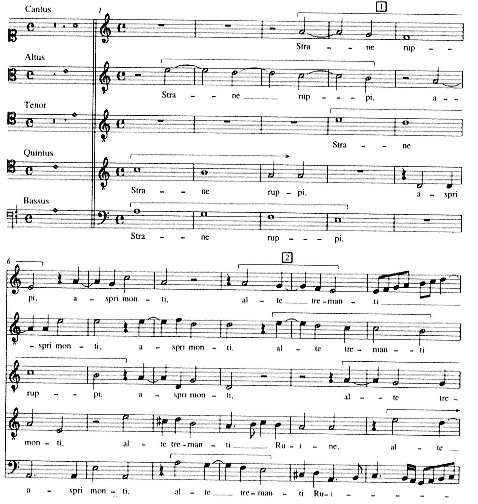
Ex. 20.
Rore, Strane ruppi, aspri monti, alte tremanti (prob. Luigi Tansillo), mm. 1-28;
Madrigali a 5, no. 7.
(continued on next page)
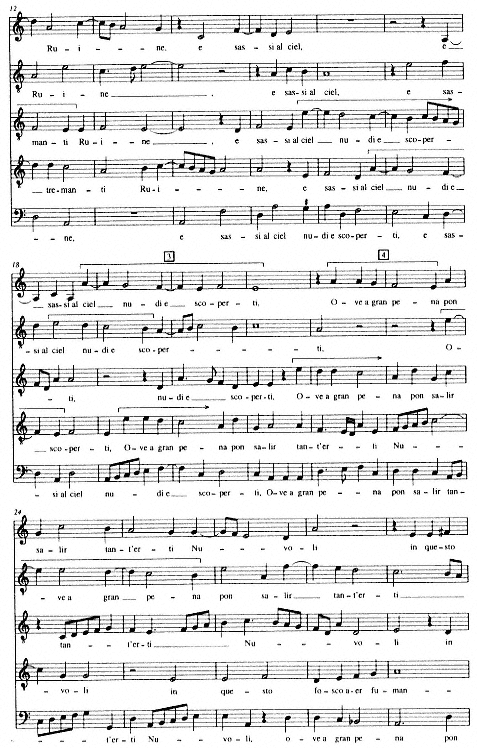
Ex. 20
(continued)
(the quintus and bassus of mm. 2-3).[33] Obsessively repeated, they give special force to the melodic whole tones that Zarlino later mentioned in connection with "asprezza, durezza, crudeltà [ed] amaritudine" (harshness, hardness, cruelty, [and] bitterness).[34]
From this stark beginning Rore drew the tetrachords into increasingly turmoiled counterpoint. With the appearance of "harsh mountains" and "trembling ruins" in m. 5 come more dissonances, declamatory ruptures, and shifts of texture. By m. 7 the suspension chains, now in diminution, generate faster harmonic shifts and remarkable dissonances. The bassus's suspended a of m. 8 becomes the middle member of a tone cluster whose outer notes (tenor g and quintus b) arrive by leap; its note of resolution, g, sounds with it not only simultaneously but in unison. As if to underscore the dissonance, the bassus rumbles through a subterranean run on "Ruine" to bring the noun phrase to an end.
In all of this, Rore made the most of the poem's noisy vowels and consonants by chiseling each of its paratactic parts into a separate musical phrase. The chain of broken syntactic bits thus receives an asymmetric musical parsing that Daniello (for one) had linked to proselike gravità in verse.[35] Deliberately measured, Rore's setting stuffed the poem's bloated diction — its a 's and o 's, r 's, s 's, t 's, and consonantal clusters,[36] with jarring discords compounding its instabilities of theme and phraseology.
The gritty style that emerged has much to do with Rore's individuality as a contrapuntist. Within the bounds of post-Josquinian, continuous polyphony, the music's surface is unusually restless. No sooner are words cranked up to a clattering, speechlike tempo than the surface turns lushly melismatic.
These two declamatory styles — recitational and melismatic — always stand in a kind of counterpose, one quickly mutating into the other. Rore individualized them contrapuntally by linking each of them to different types of chordal events and different kinds of voice leading. Crisp syllabic declamation — even and metrically stable — is usually accompanied by passages that are tonally less stable. Thus Rore often unleashed a succession of quick, erratic chordal shifts while holding the declamation steadily at the quarter note (here semiminim), as happens at the allusion to caves and stones of v. 6 (see Ex. 21, especially mm. 49-50).[37] Conversely, when the declamation unfolds in luxuriant melismas, harmonic changes become slower and
[33] Recall here that conjunct motion by major thirds, as well as from major sixths to perfect fifths, were later explicitly linked to gravity and harshness by Vincenzo Galilei in his Fronimo dialogo, nel quale si contengono le vere, et necessarie regole del intavolare la musica nel liuto (Venice, 1568), p. 13 (quoted in Claude V. Palisca, Humanism in Italian Renaissance Musical Thought [New Haven, 1985], p. 357 n. 60); see also Chap. 7 n. 60 above. Zarlino proscribed parallel major thirds in Le istitutioni harmoniche (Venice, 1558) because of the cross relations they cause (Part III, Chap. 29, p. 177).
[34] Istitutioni harmoniche, p. 339.
[35] See above, Chap. 5 n. 124.
[36] All of these were variously remarked by contemporary literary theorists for their fullness, gravity, and dissonance. On a 's and o 's see the views of Bembo, Tomitano, and Parthenio cited in Chap. 5 nn. 109, 110, 123, 138-39; on the consonants r, s, and t, see Bembo cited Chap. 5 nn. III-12 and Tomitano, nn. 123-25, among others. See also nn. 117-18 on vowel- and consonant-filled syllables.
[37] Still more so are the erratic shifts at "questo fosco aer fumanti" from v. 4, esp. m. 33; see the complete setting in Rore, Opera omnia 2:29-34.
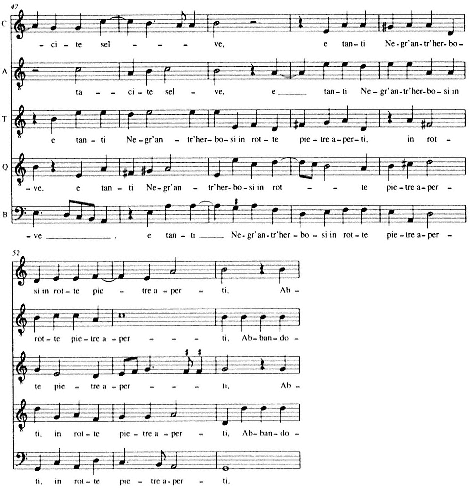
Ex. 21.
Rore, Strane ruppi, aspri monti, alte tremanti (prob. Luigi Tansillo), mm. 47-54;
Madrigali a 5 (Venice, 1542), no. 7.
less adventuresome: witness the poet's "fury" in v. II (Ex. 22), where melismas weave their way through a mild progression of fifths, C-G-C-F-C-G (mm. 100-105). Despite the wide registral spans and wild contours in some of these melismatic passages (e.g., quintus, mm. 106-7), however, Rore's voice leading minimizes the destabilizing effects of voice crossing. In this respect, such melismatic passages contrast with the many instances of chordal declamation, where voice crossing often abounds (in Ex. 20, note mm. 13-16).
This process of broadening out from syllabic textures to more florid ones that resolve instabilities of tonality and voice leading takes place repeatedly in the madrigal. It seems unlikely that Rore developed the technique by simply extending expressive possibilities he learned from Willaert, for Willaert made such pronounced
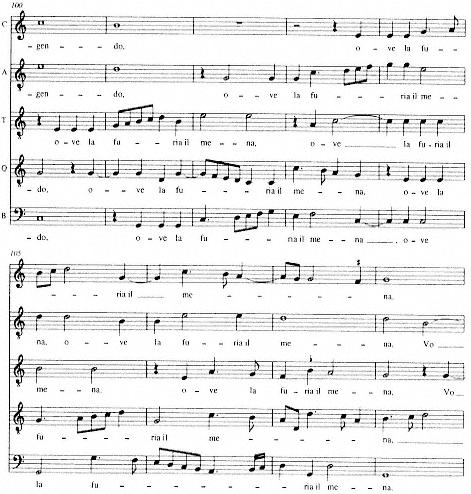
Ex. 22.
Rore, Strane ruppi, aspri monti, alte tremanti (prob. Luigi Tansillo), mm.
100-108; Madrigali a 5 (Venice, 1542), no. 7.
juxtapositions only at the most exceptional passages, like his setting of the paradox that opens Cantai, hor piango (see Ex. 45a). More typical is the diffident rhetoric of Pien d'un vago pensier (Ex. 14).
Almost invariably Rore's settings make use of Willaertian rhetoric but only for expressive contrast and rarely in so reticent a state as Willaert's own. Even a passage that explicitly recalls Willaert's plain idiom such as "Abbandonati, sterili deserti" (Ex. 23) is too idiosyncratic for Willaert in its contrapuntal construction. Here the passage earlier seen in Ex. 21 (mm. 47-54) devolves into an unsettled motivic counterpoint once all the voices have formed a perfect cadence on G. Pulled apart grammatically, the separate nouns and adjectives create ephemeral effects of a kind generally unknown in midcentury Venetian madrigals — contrapuntal disintegrations
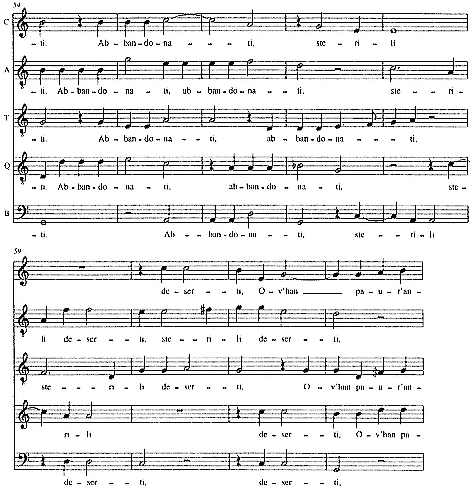
Ex. 23.
Rore, Strane ruppi, aspri monti, alte tremanti (prob. Luigi Tansillo), mm. 54-62;
Madrigali a 5 (Venice, 1542), no. 7.
that we might call, after Anthony Newcomb's descriptions of the cadences in late Ferrarese madrigals, "evaporated."[38] In mm. 55-57 the fifth motion that animates the bassus provides a little momentum and direction to help the music retain its bearings, but by mm. 57-61 a sense of disorientation begins to set in again. The lowest-sounding note constantly migrates from part to part, switching back and forth from tenor to bassus as the texture is intermittently abandoned by one voice and then another. Finally these stark motives seem to go nowhere and end in the empty major third at m. 61. Both the textural disorder and spare, sharply etched motives foreshadow Rore's later experiments of the 1550s, as well as the Luzzaschian and Monteverdian madrigals of the 1590s. The eloquent minor-sixth leap in the altus of
[38] The Madrigal at Ferrara, 1579-1597, 2 vols. (Princeton, 1980), 1:120 n. 6.
mm. 54-55 even brings to mind the kind of barren pathos evoked in the famous opening of Monteverdi's Vattene pur crudel.[39]
Strane ruppi shows other extremes foreign to Willaert beyond those exemplified here. Occasionally they crop up quite unexpectedly, as in the madrigal's voluptuous, sequence-filled fioriture — one in the cantus on "erranti" (mm. 72-76), for example, and another for the final "ombre udito" (mm. 141-42). Other melismas are surprisingly angular, like the triadic tenor at m. 27 and the quintus at mm. 22-24, seen in Ex. 20.
What is remarkable, then, is not the boldness of any one such gesture viewed in isolation, but the general saturation of them. When the book first appeared, the public was unused to such intense expression applied to vernacular poetry; nor would it have been used to hearing such dramatic poetry sung to music. In fact, neither Strane ruppi nor Altiero sasso was ever set again, despite the popularity of Rore's book, and the same can be said of a number of other poems Rore published in it.[40]Per mezz'i boschi was not reset until later decades, by the Nicosian Pietro Vinci and the Mantuan Wert. Only late in the century did its topos become a favorite in the form of Petrarch's Solo e pensoso, i più deserti campi, where it found memorable expositions at the hands of Wert and Marenzio in the 1580s and 1590s. In 1542 that topos was — and would remain for many decades — a rarity.
There is a lighter side to the Primo libro, however, one that is mostly evident in its settings of madrigals and ballate. Of these, the former evince more realism than the book's other poems, though all four settings differ poetically from even the book's most restrained sonnets. The least facile — and most influential — of them was the opening madrigal, Cantai mentre ch'i arsi del mio foco, which will figure in the next chapter in connection with resettings by madrigalists even younger than Rore, the San Marco musicians Perissone and Parabosco. For the other poems Rore turned to a more cantabile idiom, a more modest elocution, and a style that is altogether less weighty and highly wrought.
The contrast of light and weighty styles reveals itself in the exordia Rore wrote for the madrigal Hor che l'aria e la terra and the sonnet to which it is loosely related, Hor che 'l ciel e la terra e 'l vento tace (Exx. 24 and 25). The two share the same basic declamatory rhythms through the first eight syllables. But in the usual high Venetian manner Hor che 'l ciel pits a syncopated entrance of the quintus against unsyncopated entrances in the other voices and a moment later varies the soggetto in the altus with a new dotted rhythm (mm. 3-4). These irregularities instantly complicate the metric edifice. By contrast, the exordial rhythms of Hor che l'aria are
[39] See Claudio Monteverdi, Tutte le opere, ed. G. Francesco Malipiero, 17 vols. (Asolo, 1926-42; Venice, 1966), vol. 3 (1926), p. 48. Rore achieves a similar effect for the exposition of Altiero sasso.
[40] These include no. 3, Poggiand'il ciel, no. 9, Tu piangi, no. 10, Perseguendomi amor, and no. 15, Quel sempre acerbo, as well as both of the madrigals (nos. 18 and 19).
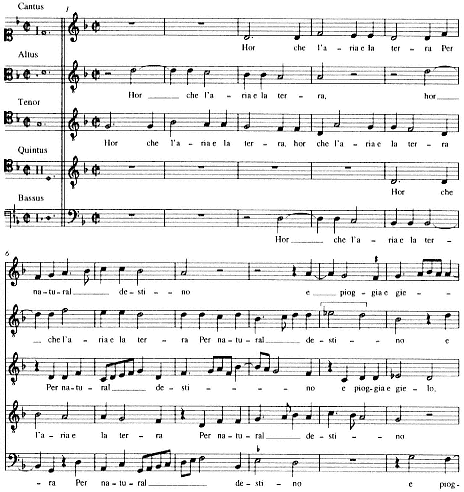
Ex. 24.
Rore, Hor che l'aria e la terra, mm. 1-11; Madrigali a 5 (Venice, 1542), no. 19.
virtually uniform through all five entrances and only vary with the reentry of the tenor in mm. 3-4. Similarly, while the opening measures of Hor che 'l ciel are drenched in semitones —

The vigorous rhetoric Rore fashioned for a poem like Hor che 'l ciel was unsuited to most madrigals, ballate, and small canzone stanzas. Perhaps the most unequivocal expressive departure of Hor che 'l ciel from the milder Hor che l'aria comes at the ravishing contrasts of vv. 5-6, where Petrarch jolts the sonnet from the serenity of the first quatrain to introduce a sudden shift to first-person parataxis. By contrast with the tranquil scene painting of vv. 1-4, the verbs of v. 5 move along in an unsettled, if weary, dissolutio. Suddenly, as the parataxis breaks, the verse tumbles in enjambment toward the oxymoron of v. 6.

Ex. 25.
Rore, Hor che 'l ciel e la terra e 'l vento tace (Petrarch, no. 164), mm. 1-12;
Madrigali a 5 (Venice, 1542), no. 2.
Hor che 'l ciel e la terra e 'l vento tace Now that the heavens and the earth and the wind are silent,
E le fere e gli augelli il sonno affrena, And sleep reins in the beasts and the birds,
Notte 'l carro stellato in giro mena Night drives her starry chariot around
E nel suo letto il mar senz'onda giace And in its bed the sea lies without a wave. 4
Veggio, penso, ardo, piango, e chi mi sface I am awake, I think, I burn, I weep; and she who destroys me
Sempre m'è inanzi per mia dolce pena; Is always before me, to my sweet pain;
Rore's setting orchestrates the resultant interplay of syntax and rhetoric in vv. 5-6 while maximizing the expressive possibilities broached by the instabilities of the exordium (Ex. 26). It sets off the syntactic disjunction of the verbs in v. 5 by
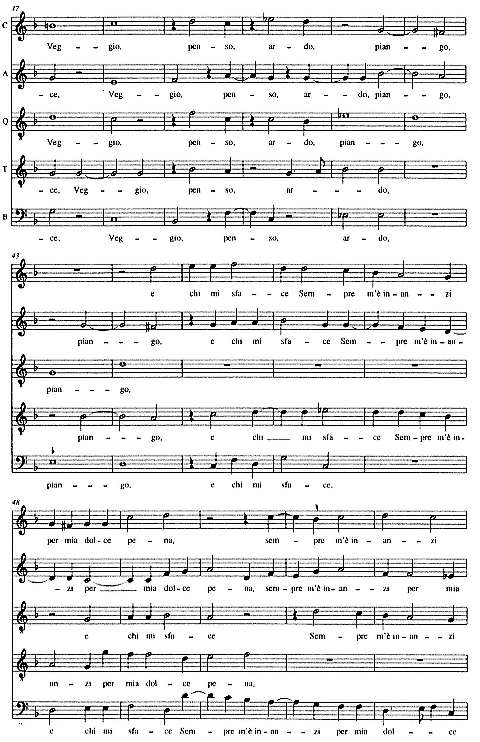
Ex. 26.
Rore, Hor che 'l ciel e la terra e 'l vento tace (Petrarch, no. 164), mm. 37-56;
Madrigali a 5 (Venice, 1542), no. 2.
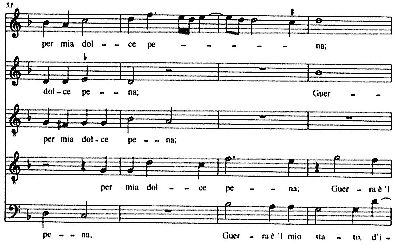
Ex. 26
(continued)
suddenly slowing the declamatory speed. Each verb is declaimed in a plaintive two-note gesture (often a simple minor second) and isolated by rests. Measures 37-44 move through an unpredictable harmonic course, irregular rhythms, and a texture wholly variable in density and weave. Ultimately, this passage forms a foil to the music starting at mm. 44-45 by distinguishing the shift to third person at the end of v. 5 ("E chi mi sface / Sempre m'è innanzi") with a return to the standard declamatory rate and counterpoint. First set off by rests, the clause is realized in a rhythmic parallel that energizes the enjambment and embodies it iconically through various rising and falling melodies, at the same time as it accentuates the words' expressive asymmetries.
Rore's Primo libro — and especially the play of these two text settings — nonetheless attests to the continued vitality of lighter poetic forms in Venetian printed repertories, not least because it represents the first printed madrigal book of such weight. Some of the lighter settings published alongside sonnets undoubtedly carried a whiff of nostalgia for the prettier, more chansonesque idioms of Verdelot and Arcadelt. Others offered more neutral versions of the new Venetian style, possibly more congenial to the amateurs who had purchase on printed books. Rore's Second Book, a printer's compilation drawn from a variety of styles and authors, furnished numerous examples of these earlier idioms, along with retrospective settings and new-styled Venetian sonnet settings.
Secondo Libro a 5 (1544): Anthology in the Guise of Single-Author Print
The distinctive makeup of Rore's second book sharpens the contrast between Petrarchan sonnet settings and settings of lighter and (in part) more realistic verse
seen in his first. Of its scant eight madrigals by Rore, four set sonnets of Petrarch, two set occasional sonnets, one an occasional cinquecento madrigal, and one a little ballata-madrigal (see Table 8). All four of the Petrarch settings are placed consecutively (as nos. 15 to 18), the others, all by unidentified poets, ranged throughout the print (nos. 1, 3, 14, and 26). We will see that, as in Book One, this rough bifurcation of sonnets and nonsonnets throws into relief a general stylistic one.
With less than a third of its twenty-seven settings by Rore, however, we can hardly take at face value the title under which Gardane marketed the book: Di Cipriano il secondo libro de madregali a cinque voci insieme alcuni di M. Adriano et altri autori a misura comune novamente posti in luce a cinque voci.[41] Rore's contributions form only a few points on a map that plots a significant corner of the northern madrigalian dialect. Among the other madrigals in the volume, the most prestigious and prominently placed are Willaert's. The Secondo libro was the first publication to print Willaert's and Rore's madrigals in quasi-symmetrical proximities: Willaert's first setting, no. 2, was wedged between Rore's first two and his final one, no. 27, just after Rore's last (as if giving Willaert the last word). No. 2, the lengthy ballata-madrigal Sciocco fu il tuo desire (see Chap. 7, pp. 221-22), was followed by a sonnet setting of Rore's; and no. 27, the ten-line madrigal Qual vista sarà mai, came after Rore's little ballata-madrigal Deh, se ti strins'amore. Thus two "pairs" framed the book at front and back, with madrigals roughly equivalent in weight and size by each composer making up each pair. It is not surprising that the centerpiece of the book, Rore's four settings of Petrarch's sonnets, is unmatched by Willaert's contributions, since Willaert published none of his Petrarch sonnet settings until 1559.
Of the other contributors, the Roman-based Fleming Hubert Naich follows Rore in number with seven madrigals (nos. 4, 10-12, 19, and 24-25). His settings probably served as fillers, however. They are among the least engaged in the Venetian style that otherwise stamps the print — the least concerned with textual rhetoric or polyphonic breadth — and but for one setting of a Petrarch sonnet (no. 24), bizarrely truncated after seven verses, they are almost wholly disengaged from the high-styled literary verse prevalent among Venetians.[42]
The single madrigals by Arcadelt and Ferrabosco (nos. 20 and 21), both of whom had ties not to Venice but to Rome, also stand outside the book's Venetian charac-
[41] In addition, eight of the madrigals in the book had appeared (undoubtedly before Gardane's edition) in Scotto's reprint of Rore's First Book of the same year, of which six of the madrigals were Rore's. See Il nuovo Vogel no. 2391 (2:1480-81) and no. 2401 (2:1485-86) — Scotto's reprint of Book One and Gardane's edition of Book Two, respectively — and see the comments of Lewis, Antonio Gardane, p. 436, and the forthcoming catalogue of Scotto's printing house by Jane A. Bernstein.
[42] Another sonnet of Naich is apparently occasional, addressed to the "sacrato impero" and set in one part (no. 12). Four other settings are of madrigals (nos. 10, 11, 19, and 25) and another a short canzone (no. 4), all anonymous. For a good biography of Naich and summary of his madrigalian style see Don Harrán's foreword to his edition of The Anthologies of Black-Note Madrigals, Corpus mensurabilis musicae, no. 73, AIM, 5 vols. (Neuhausen-Stuttgart, 1978), I:xxix, and idem, "Hubert Naich, Musicien, Académicien," Fontes artes musicae 28 (1981): 177-94. It should be noted that all of Naich's madrigals had been published around 1540 by the Roman printer Antonio Blado in Naich's Exercitium seraficum (Rome, [ca. 1540]).
| ||||||||||||||||||||||||||||||||||||||||||||||||||||||||||||||||||||||||||||||||
(table continued on next page)
(table continued from previous page)
| |||||||||||||||||||||||||||||||||||||||||||||||||||||||||||||||||||||||||||||||||||||||||||||||
(table continued on next page)
(table continued from previous page)
| |||||||||||||||||||||||||||||||||||||||||||||
ter,[43] but each of the other contributors was in some way aligned with Venice stylistically and, in most cases, biographically. Clearest among these were Willaert's students Perissone Cambio and Girolamo Parabosco. Perissone's bipartite setting of a spiritual sonnet (no. 5) and Parabosco's setting of an octave adapted from Petrarch (no. 13) are both unmistakably Venetian works that will be taken up in Chapter 9. For both composers, the Secondo libro was the venue of their first secular vocal publications, along with Doni's Dialogo della musica of the same year.
Less obvious but sound enough claims to Venetian provenance fall to two final contributors, Jacquet Berchem and Leonardus Barré. The prolific Berchem spent time in Venice during the 1540s and may well have been sponsored by an ostensible
[43] Harrán, ed., Anthologies of Black-Note Madrigals I:xxix.
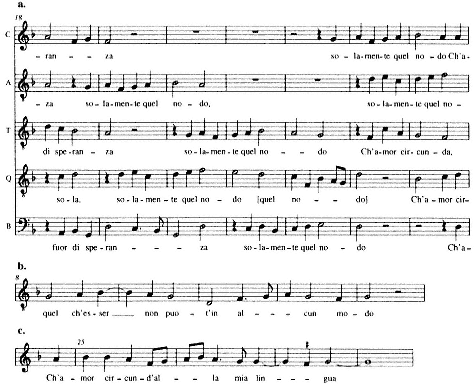
Ex. 27.
Giachet Berchem, Lasso, che desiando (Petrarch, no. 73, stanza 6): a, mm.
18-24; b, tenor, mm. 8-11; c, cantus, mm. 24-28; Di Cipriano il secondo libro
de madregali a 5 (Venice, 1544) (RISM 154417 ), no. 6.
patron of Willaert's, Marcantonio Trevisano.[44] Yet his contribution of a Petrarchan canzone stanza, Lasso, che desiando (no. 8), shares little of the syntactic and accentual precision or rhetorical logic of Willaert's settings, and the same is true of the Petrarchan settings, six in all, in his first book of 1546.[45]Lasso, che desiando does make modest efforts at Willaertian rhetoric, but it also contains instances of awkward text setting of a sort that virtually never mar the settings of Willaert's immediate circle. (Note, for example, in Ex. 27: a) the unvaried misaccentuation of "solamente" and the quintus's broken "sola-, solamente" [mm. 18-20]; b) the tenor's clumsy declamation of the cadential "non puot'in alcun modo"; and c) likewise, the misaccented cadence on "Ch'Amor circund'alla mia lingua.")
The work of the lesser-known Barré shows surprisingly deeper sympathies with Venetian practices than Berchem's. Barré had already debuted as a member of the
[44] See Appendix to Chap. 3, as well as Dale Emerson Hall, "The Italian Secular Works of Jacquet Berchem" (Ph.D. diss., The Ohio State University, 1973), esp. pp. 21-22 and passim; and George Nugent, "The Jacquet Motets and Their Authors" (Ph.D. diss., Princeton University, 1973).
[45] Mod. ed. Jessie Ann Owens, The Italian Madrigal, vol. I (New York, 1993). The ambiguities of text underlay in Berchem's book almost never appear in those of Willaert's students at San Marco.
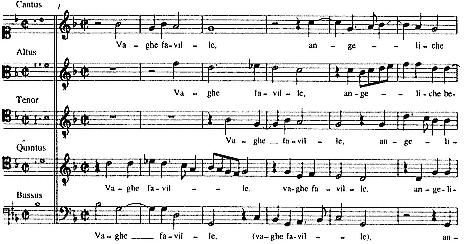
Ex. 28.
Leonardus Barré, Vaghe faville, angeliche beatrici (Petrarch, no. 72, vv. 37-45), mm. 1-6;
Di Cipriano il secondo libro de madregali a 5 (Venice, 1544) (RISM 154417 ), no. 8.
(then fledgling) Venetian school in the five-voice anthology Le dotte, et eccellente compositioni de i madrigali a cinque voci da diversi perfettissimi musici fatte, printed by Scotto in 1540 (RISM 154018 ).[46] Though he was a papal singer, the print's title page dubbed him a "discipulo" of Willaert's. The claim is not sustained by other biographical findings, but the style of his Vaghe faville, angeliche beatrici (no. 8), a setting of the sirima from the third stanza of Petrarch's canzone no. 72, makes it entirely plausible. Barré set the text in a motet texture, with meticulous accentuation and declamation and all the choice gauging of musical to verbal cadence emphasized by Willaert and Zarlino. As seen in Ex. 28, the first three voices of the exposition immediately preempt the possibility of a dominating tactus by staggering their entrances at the minim with the device that Zarlino called a "sospiro."[47] Subsequent entries are equally irregular, metrically and melodically, and delicately inflected with e-flats in a way that prefigures the nuanced Venetian-styled reading of subsequent passages.
A few observations, then. First, the Secondo libro, like Doni's Dialogo della musica, already evinces the diffusion of Venetian style beyond the chapel members and Rore to a larger circle. In this respect, the book offers a useful way to see the two composers now regarded as the style's most illustrious practitioners in relation to
[46] See Fenlon and Haar, The Italian Madrigal, pp. 313-16.
[47] See Le istitutioni harmoniche, Part III, Chap. 44, and Chap. 6 above, Ex. 5. The exposition's soggetto likewise collaborates in shaping Barré's introverted style: carried by the cantus and tenor as the third and fifth voices to enter, it conforms to the kind of exposition cautiously approved by Zarlino in which non-soggetto voices enter first, adapting themselves to a "real" soggetto that materializes only later. See Le istitutioni harmoniche, Part III, Chap. 28, and Chap. 6 above, n. 81.
surrounding lesser lights.[48] Second, to date none of the poets who authored verses in the Secondo libro has been identified save Petrarch (and provisionally the Petrarchan adaptation, no. 13). Given increasingly useful (if still limited) apparatuses for searching cinquecento poetic sources, this profusion of anonymous poetry looks less and less coincidental. Even in its own time the book probably divided roughly into anonymous poetry, on the one hand — synonymous with poetry never meant for collection or preservation outside of music — and Petrarch's poetry, on the other. Perhaps only one other print of Venetian provenance displays a division as strict, namely Perissone's Primo libro a 4 of 1547, which figures in my discussion in Chapter 9. Third, the rough division of poetry into two large branches — lighter anonymous and weightier Petrarchan — has broader ramifications. Petrarch's poems form the basis of a higher, more remote expression, while the anonymous ones run the gamut: some are set in styles close to those of the Petrarch settings, others are much lighter in tone. (The same sort of bifurcation marks Willaert's entire corpus, of course — a bifurcation duplicated in its patterns of preservation.) By juxtaposing Petrarchan settings with settings of anonymous verse, composers set a probing and timeless aesthetic against the simpler, more mundane countertypes produced by transient Petrarchan imitators.
The latter have their most characteristic embodiment in settings of occasional verse, whose worldly aspect manifests itself in three of Rore's four non-Petrarch settings, all of them celebratory: two wedding sonnets (nos. 1 and 14) and an encomium of one Isabella of Cremona (no. 3). Verse like this was much at home in the madrigalian anthology, since both celebratory settings and printed anthologies bore the social signs of commodification. Whether vended by composers or printers, both were publicly produced for capital consumption with an ear to easy appeal.
The opening madrigal of the Secondo libro, a sonnet for a Gonzaga wedding, speaks precisely out into this public space. The text opens in the first-person plural, familiar from songs for carnival and theater, calling up the image of costumed singers staging their song for assembled wedding guests.
Cantiamo lieti il fortunato giorno Let us sing joyously about the happy day
Che strins'a un nodo sacr'almo e tenace That bound in a sacred, life-giving, constant knot
Coppia si degna e con ardente face Such a worthy couple, and adorned this
Il fe divino amor leggiadro adorno. Divine, happy love with an ardent light. 4
Cantiamo lieti, che già d'ogn'intorno Let us sing joyously, for heaven is already rejoicing
S'allegr'il cielo, l'aria e 'l vento tace, All about, the air and the wind are silent,
[48] An inverse pattern of dissemination can be seen in the 1546 reprint of Verdelot's six-voice madrigals, Madrigali di Verdelot et de altri autori a sei voci novamente con alcuni madrigali novi ristampati et corretti (originally titled La piu divina . . . musica in 1541), printed, like the original ed., by Gardane. Its inclusion of works by Willaert, Parabosco, Perissone, Berchem, and Nollet (all of them represented in Doni's Dialogo della musica ), along with those of Verdelot, Festa, Arcadelt, Maistre Jhan, and others, justifies Fenlon and Haar's description of the reprint as having "a more Venetian cast" than the original ed. (The Italian Madrigal, pp. 317-18).
E 'l bel sereno appare, e già si sface And the weather appears serene, and already
A tutti gli animanti un bel soggiorno. A beautiful site is arrayed before all the lively ones. 8
La terra di novelli e vaghi fiori The earth paints itself with new and lovely flowers
Ovunque si dipinge e copre il manto And covers the mantle,
Di la felice et aurea età presaga: Foreshadowing the happy and golden age: 11
Verà che sol il mondo acqueti e It will come to pass that the sun may appease and honor
honori the world
Da l'alto seme glorioso santo Through the great, glorious, saintly seed
D'il fiero Marte e l'unica Gonzaga. Of the proud Mars and the unique Gonzaga.[49] 14
Rore's setting revels in sparkly melodies, with episodes of patter declamation, speechlike rhythms, and (intermittently) extended periods reminiscent of song. In the cantus's first fifteen measures a continuous strain arches from f to cc and back, with graceful diminutions cadencing on the final in the approach to the "Coppia si degna." In keeping with this melodious character, the setting's large-scale structure is more sectionalized than those Rore designed for Petrarch's sonnets. Highlighting the refrainlike anaphora of the first two quatrains, verses 4 and 6 both cadence with the full complement of five voices and on the final, which dominates the setting, followed by the unpretentious modal degrees a (mm. 30, 67, and 89) and c (mm. 61 and 84). Rore executes all this with crisp dispatch — a mere 114 measures for fourteen endecasillabi, whereas his settings of Petrarch's sonnets generally average between 130 and 160 measures. His other wedding sonnet, Scielgan l'alme sorelle, is equally short and similar in style, with buoyant rhythms, brisk declamation, and several multivoice cadences. In a way almost unknown in Rore's Petrarch settings (and more in keeping with later pastoral styles), many of its melismas are wholly unsyncopated (see the one drawn from the cantus in Ex. 29).
Even though the ethos of Scielgan l'alme sorelle is far lighter than that of Willaert's Petrarchan sonnet settings, the work exploited certain Musica nova -like techniques to evoke local rhetorical events without recourse to contrapuntal cadences. Most remarkable in this respect is the way in which Rore gives definition to the catalogue of virtues that opens the sestet (and the seconda parte; see Ex. 30). The passage did not escape Einstein's attention, and for good reason.[50] Yet his claim that "in 1540 only Rore could write a section as 'articulated'" as this one does not hold up in the face of an analogous passage from Petrarch's I vidi in terra angelici costumi set by Willaert; like Rore's exordium, Willaert's also opens the sestet and seconda parte (Ex. 31). In composing "Ardir, senno, virtù, bellezza e fede," the anonymous poet of
[49] The poem, for a spring wedding between a female member of the Gonzaga family and (possibly) a member of a Roman family, is difficult to translate because the grammatical relationships in vv. 3-4 and v. 12 are unclear. I am grateful to Stefano Castelvecchi for his help with it.
For Rore's setting see Rore, Opera omnia 2:108-12.
[50] See The Italian Madrigal 1:401.

Ex. 29.
Rore, Scielgan l'alme sorelle in li orti suoi, cantus, mm. 72-76; Di Cipriano il
secondo libro de madregali a 5 (Venice, 1544) (RISM 154417 ), no. 14.
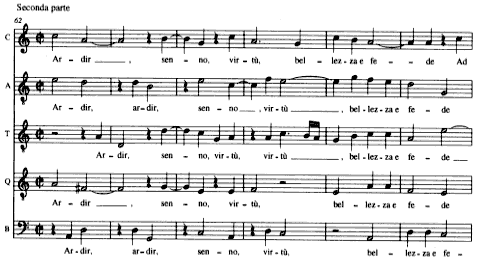
Ex. 30.
Rore, Scielgan l'alme sorelle in li orti suoi, mm. 62-67; Di Cipriano il secondo libro
de madregali a 5 (Venice, 1544) (RISM 154417 ), no. 14.
Scielgan l'alme sorelle surely glossed the rhythms, words, and word sounds of "Amor, senno, valor, pietate e doglia" from Petrarch's I vidi in terra. But did Rore's setting gloss Willaert's? This question raises issues of both chronological and musical relationships between the two. A definitive resolution of chronology is not possible, though it is likely that Willaert's setting came first. Einstein's view that in general the Second Book represents the earliest stylistic layer in Rore's oeuvre, that the pieces in it were leftovers from the First Book, and that Scielgan l'alme sorelle dates from 1540 (a claim unsupported by circumstantial evidence) was undergirded by his teleological view of the repertory.[51] It conflicts with the model I propose for Venetian madrigals in which different styles endured concurrently in connection with different kinds of poetry, for different kinds of occasions, and for dissemination in different kinds of sources. Probably the works printed in 1544 were mostly newer
[51] "Rore's eight compositions for this book . . . seem to me to represent a mere gleaning, all of which antedates the first book of 1542. This follows not only from their notation but also from their character, which is less sharply defined. One of them, Deh, se ti strins'amore, is a youthful work, still wholly in the style of Verdelot; others are occasional pieces whose early date will perhaps be determined someday by inferences from the texts" (ibid.).
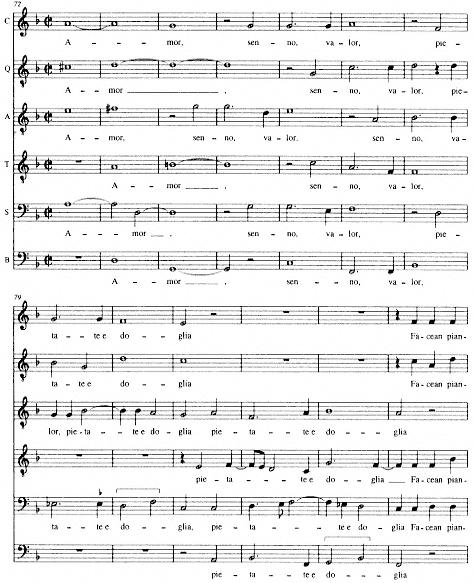
Ex. 31.
Willaert, I vidi in terra angelici costumi (Petrarch, no. 156), mm. 72-84; Musica
nova (Venice, 1559), no. 19.
than those of 1542 — at least in part — and more suited (as I have suggested) to inclusion in an anthologistic potpourri.
Questions of musical relationships are less difficult, for the two employ a fragmentary motivic counterpoint that is much alike. Despite differing pitch systems —


At least one other passage in the Second Book raises similar questions, a line from the madrigal Sfrondate, o sacre dive, v. 8, "Sgombrino l'altre voglie aspr'e selvaggie." This line echoes the incipit of Petrarch's sonnet no. 265, Aspro core e selvaggio e cruda voglia, just as Rore's setting echoes the striking exordium of Willaert's Musica nova setting of it. As noted in Chapter 7, Claude Palisca (among others) has remarked on the harsh parallel major thirds and major-sixth-to-perfect-fifth progressions of Willaert's exposition, as well as its copious deployment of melodic major seconds and thirds (see Ex. 16).[52] As seen in Ex. 32, Rore's setting makes comparable parallel motion at the words "aspr'e selvagge" and deploys linear major seconds copiously between the respective syllable pairs "a - spr'e" and "sel - vag-," with their descending tetrachords. (Minor seconds, by contrast, more often connect the two words to each other.) Given the intensity and exposed position of the parallel-third motion, later proscribed by Zarlino,[53] Willaert's passage bears signs of having served as the model.
Even so, correspondences like these suggest only a very partial obeisance toward Willaert on Rore's part, in addition to confirming Rore's participation in Willaert's practice through their mutual preoccupations with dense five-voice polyphony, Petrarch's sonnets, bipartite settings, and the like. Other aspects of Rore's madrigals — even general ones like choices of sonnets, ordering of sonnets by mode, extensive use of black notation, expansive proportions, and florid melismas — have little or no precedent in Willaert.
Again the musical clues to this relationship rest mainly on the Primo libro, for the Secondo libro is not really a single-author monument, as its title would have it — not a book by Rore at all, but one made to honor and profit from him. For us the Secondo libro helps situate Rore's early practice by clarifying his relationship to some of his contemporaries and affirming his recently gained status as Willaert's equal. In
[52] See n. 33 above and Zarlino, Le istitutioni harmoniche, Part IV, Chap. 32.
[53] See nn. 33 and 52 above. Vincenzo Galilei first drew attention to Willaert's breaking of the rule in Aspro core in order to justify it as an instance of imitation; see also Chap. 7 above, n. 60.
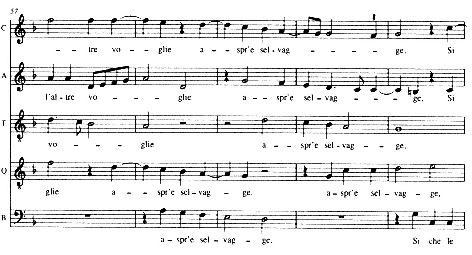
Ex. 32.
Rore, Sfrondate, o sacre dive, mm. 57-61; Di Cipriano il secondo libro de madregali
a 5 (Venice, 1544) (RISM 154417 ), no. 3.
this regard we should recall that Rore was the only composer in the Secondo libro by whom there were settings of Petrarch's sonnets at all, save the seven odd lines set by Naich. The only other complete settings of sonnets (both anonymous) are those of Willaert and his pupil Perissone, the latter of whom managed, through an ambitious act of entrepreneurship, to become the first acolyte to issue a book dominated by sonnet settings after Willaert's and Rore's leads.
Taken together, Willaert and Rore make an odd pair of figureheads: the one eminently visible to historical view, the other cloaked in mystery; the one moored in a single symbolic space, the other seemingly aloof from the enveloping constraints of place. The aesthetic hegemony that Rore was able to elude was rabidly Ciceronian and anti-Dantean. Even with such minimal information on Rore's ties and where-abouts as we now have, much can be understood by perceiving that his allegiances to Venice, with the many taboos and biases it demanded, must have been far more tenuous than Willaert's. To say so constitutes a substantial revision of long-standing assumptions initiated in the mid-nineteenth century by Francesco Caffi, who claimed that Rore had been a singer in the Chapel of San Marco.[54] Caffi evidently played off two notions that remain much discussed in more recent literature: one was a tradition dating back to the mid-sixteenth century for referring to Rore as Willaert's disciple, which emerged only in 1548 with the dedication of Scotto's edition of Rore's Third Book to Gottardo Occagna;[55] the other was the problematic
[54] See Francesco Caffi, Storia della musica sacra nella già cappella ducale di San Marco in Venezia (dal 1318 al 1797): riedizione annotata con aggiornamenti bibliografi (al 1984), ed. Elvidio Surian, rev. ed. (Florence, 1987); Surian corrects Caffi on p. 94 n. 2.
[55] See Chap. 3 n. 32, above. In 1549 Scotto again described works by "Adriano Vuigliart, et Cipriano de Rore suo discepolo" on the title page of the print Fantasie, et recerchari a tre voci (RISM 154934). The works in question include five madrigals, centrally placed and printed in alternation by composer (three by Rore and two by Willaert), in addition to seven ricercars by Willaert. A still more equal association between the two was implied two years later by Antonio Gardane's inclusion of two three-voice settings of "Regina caeli, laetare," one each by Willaert and Rore, in a related print (RISM 155116, containing seven of the ricercars by Willaert that were printed in 154934). These two settings used the same cantus firmus and were printed on facing pages.
assumption that whoever was chapelmaster must have had priority in fashioning the new style. The possibility that Caffi's assertions might someday prove right has now been effectively nullified by Giulio Ongaro's detailed documentary study of the chapel in Willaert's time,[56] but Caffi's opinion forms only the first in a line that has long viewed Rore unproblematically as Willaert's student.[57]
All the same, if Rore was as unfettered in the early forties as he seems — freelancing for worldly, nomadic Florentines and the like — we should recall that the allegiances to which Willaert was bound were multiple as well. Even the staunch, seemingly monolithic Venetianism Willaert served was fused with Tuscan tastes — not only through the elitism imposed on him by Capponi but by the Tuscan linguistic norms that Venetians promoted. In the ensuing chapter we will see some of the madrigalistic choices this alliance drew from students who appropriated and disseminated Venetian musical norms in the 1540s and 1550s.
[56] "The Chapel of St. Mark's at the Time of Adrian Willaert (1527-1562): A Documentary Study" (Ph.D. diss., University of North Carolina at Chapel Hill, 1986).
[57] See Einstein, The Italian Madrigal 1:384, and Meier, ed., Rore, Opera omnia 2:ii.